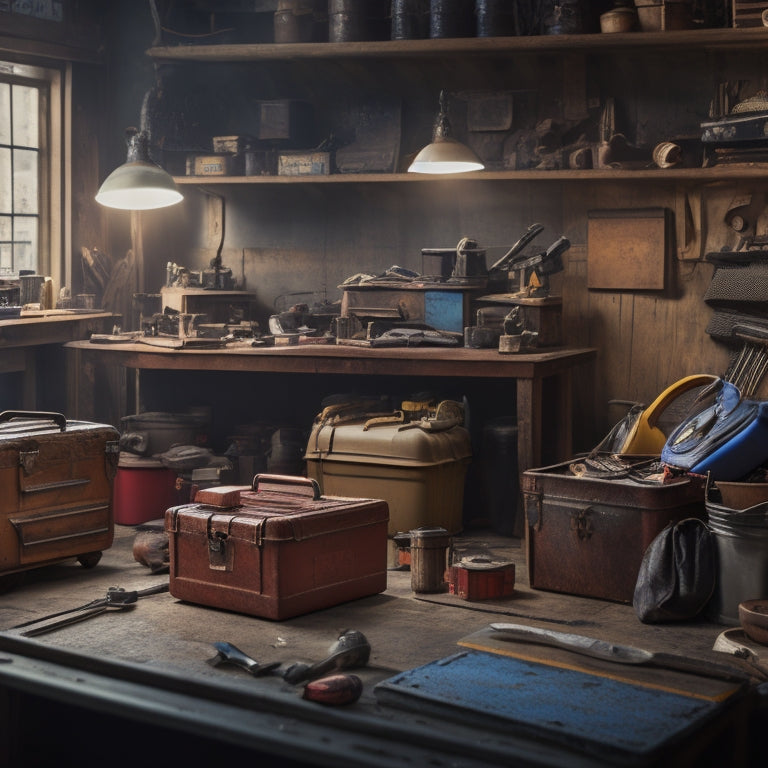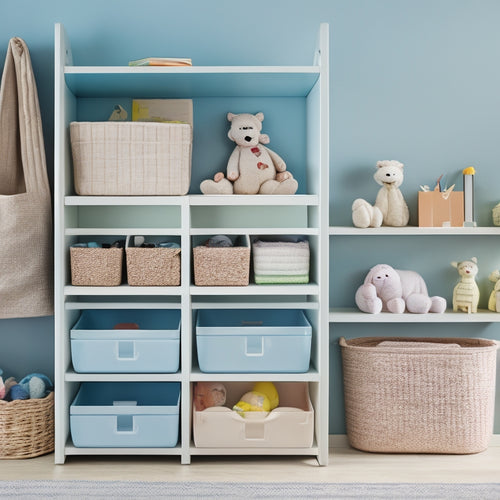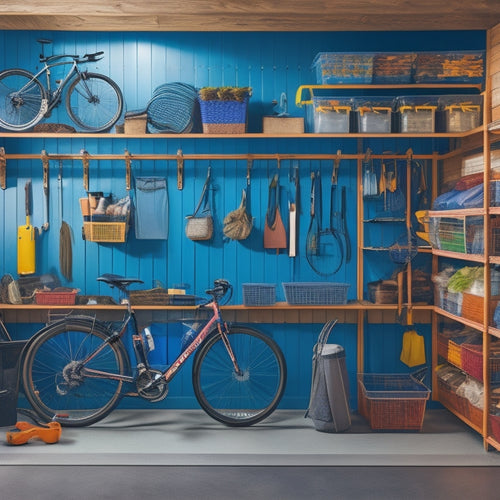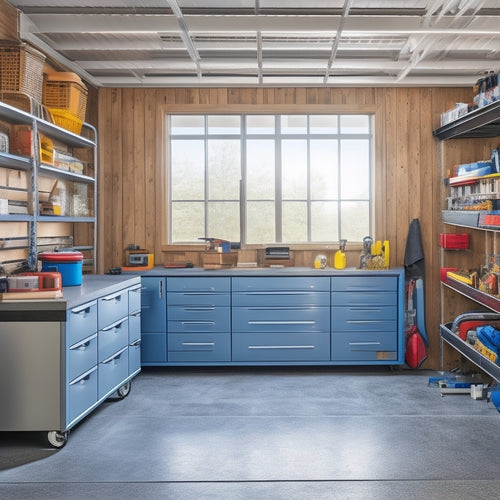
Choosing the Right Portable Tool Box
Share
When choosing the right portable tool box, you'll need to assess your tool storage needs by identifying the types of tools you'll be storing, your primary tool usage, and project frequency. Consider the size and weight of the tool box, balancing storage space with portability, and prioritize accessibility features like ergonomic handles and customizable compartments. Material durability, security features, and budget constraints are also key factors to evaluate. As you weigh these factors, you'll be well on your way to finding a portable tool box that meets your unique needs, and exploring these considerations in more depth will reveal the perfect fit for your toolkit.
Key Takeaways
- Assess tool storage needs, including types, primary usage, and project frequency to determine the right portable tool box for your requirements.
- Balance size and weight considerations, prioritizing compact designs, ergonomic handles, and weight capacity to ensure portability and safety.
- Evaluate material and durability options, choosing between plastic and metal, and considering features like waterproofing, reinforced corners, and heavy-duty latches.
- Look for organization and accessibility features, such as adjustable dividers, quick access trays, and ergonomic handles, to optimize tool retrieval and minimize clutter.
- Consider security and locking mechanisms, including lock and key systems, biometric authentication, and tamper-evident latches, to protect your tools from theft and unauthorized access.
Determining Your Tool Storage Needs
How do you envision your ideal tool storage setup - one that efficiently organizes your tools, saves you time, and increases productivity?
To determine your tool storage needs, you need to take into account the types of tools you use most frequently and how often you work on projects.
Take stock of your tool types, including hand tools, power tools, and specialized equipment.
Do you work primarily with woodworking tools, automotive tools, or a mix of both? Identifying your most-used tools will help you prioritize storage space and design.
Project frequency is also essential.
Do you work on projects daily, weekly, or sporadically? If you're a frequent user, you'll want a portable tool box that's easy to access and transport.
If you only work on projects occasionally, you might prioritize storage capacity over portability.
Size and Weight Considerations
Your tool box's size and weight greatly impact its portability, accessibility, and overall usability. A larger tool box may provide more storage space, but it can be cumbersome to transport, potentially leading to accidents or injuries.
On the other hand, a compact design can make it easier to maneuver, but may not hold all your tools.
When selecting a portable tool box, consider the following:
-
Dimensions: Look for compact designs that can fit in tight spaces, such as a work truck or small workshop.
-
Weight distribution: Verify the tool box has an ergonomic handle that allows you to lift and carry it comfortably, reducing strain on your back and shoulders.
-
Weight capacity: Check the tool box's weight capacity to confirm it can hold the weight of your tools without compromising its structural integrity.
Material and Durability Options
As you weigh your portable tool box options, the material and durability of the box itself become critical factors in guaranteeing your tools remain protected and organized.
You'll need to decide between plastic versus metal constructions, each with its pros and cons. Plastic tool boxes are often lighter, more corrosion-resistant, and less expensive, but may lack the longevity and strength of metal boxes.
Metal tool boxes, on the other hand, offer superior protection and can withstand harsh environments, but may be heavier and more prone to rust.
When it comes to durability, look for features like reinforced corners, heavy-duty latches, and sturdy handles.
Waterproof options are essential for protecting your tools from moisture and humidity. Some tool boxes feature IP65 ratings, which guarantee protection against dust and water jets.
Others may have seals or gaskets to prevent water ingress. Consider the environmental conditions you'll be working in and choose a tool box that can withstand them.
Organization and Accessibility Features
Within the portable tool box, a well-designed organizational system is essential for efficient tool retrieval and storage. You need to be able to find what you need quickly and easily, without having to dig through a cluttered box.
This is where tool compartmentalization comes in. By dividing the box into separate compartments, you can keep similar tools together and prevent them from getting jumbled.
When evaluating a portable tool box, look for the following organization and accessibility features:
- Adjustable dividers: These allow you to customize the compartments to fit your specific tools and needs.
- Quick access trays: These provide a convenient place to store frequently used tools, so you can grab them quickly.
- Ergonomic handles: These make it easy to carry the box, even when it's fully loaded, reducing the risk of strain or injury.
Security and Locking Mechanisms
When selecting a portable tool box, you'll want to take into account the security features that protect your prized tools and equipment.
Lock and key systems provide a high level of security, while tamper-evident latches offer an additional layer of protection against unauthorized access.
Lock and Key Systems
Frequently, you'll find that portable tool boxes feature a lock and key system to safeguard your important tools and equipment from theft or unauthorized access. This system serves as the primary defense against potential thieves or unwanted users.
When evaluating a portable tool box, it's crucial to take into account the lock and key system's quality and durability.
Here are three key aspects to look for:
- Key types: Look for tool boxes with high-security keys that are difficult to duplicate or pick. Some tool boxes may feature electronic keys or biometric authentication for added security.
- Lock durability: Assess the lock's build quality and material. A sturdy lock with a resilient mechanism will provide better protection against forced entry or tampering.
- Key management: Take into account tool boxes with key management systems that allow you to track and control access to your tools and equipment.
Tamper-Evident Latches
Beyond the lock and key system, portable tool boxes often incorporate additional security features to further safeguard your prized tools and equipment. One such feature is the tamper-evident latch, designed to provide an extra layer of protection against unauthorized access.
These latches are typically designed with tamper-evident features that make it obvious if someone has attempted to break into your tool box. For instance, some latches may have a fragile material that breaks or changes color when force is applied, indicating that someone has tried to tamper with the lock. Others may have a latch design that leaves a visible mark or impression when an unauthorized attempt is made.
When selecting a portable tool box, look for tamper-evident latches that meet your security requirements. Consider the level of protection you need, the type of tools you'll be storing, and the potential risks of theft or vandalism.
Budget and Brand Comparisons
As you set out to choose a portable tool box that meets your needs, considering your budget and comparing brands become essential steps in the decision-making process.
You need to balance your budget constraints with the quality and features you require. A reputable brand can provide you with a durable and reliable tool box that guarantees your tools are safe and organized.
When comparing brands, look for the following key factors:
-
Brand reputation: Research the brand's history, customer reviews, and ratings to guarantee you're investing in a high-quality product.
-
Warranty and support: Check the length of the warranty and the level of customer support provided by the brand in case you encounter any issues.
-
Material and build quality: Assess the durability and sturdiness of the tool box, including the material used and the construction of the compartments and latches.
Frequently Asked Questions
Can I Customize a Portable Tool Box to Fit My Specific Needs?
You can customize a portable tool box to your specific needs by exploring customization options, such as adjustable compartments, personalized tool box features, and modular designs, ensuring a safe and efficient workspace that meets your unique requirements.
Are Portable Tool Boxes Suitable for Outdoor Use in Harsh Weather?
You'll be surprised to know that 70% of outdoor workers experience equipment damage due to harsh weather. When it comes to portable tool boxes, you need weather resistance and material durability to guarantee your tools stay protected and functional in extreme conditions.
Can I Attach My Portable Tool Box to a Truck or Trailer?
You'll want to make certain your portable tool box is designed with truck compatibility and trailer attachment in mind, featuring reinforced mounting points and corrosion-resistant hardware to securely fasten it to your vehicle, assuring safe transport in harsh environments.
Are There Portable Tool Boxes With Built-In Work Surfaces?
You'll find portable tool boxes with built-in work surfaces, offering convenience and efficiency. Look for durable materials like aluminum or steel to guarantee the work surface withstands heavy use, and consider work surface options like removable trays and adjustable heights for ideal workflow.
Can I Use a Portable Tool Box as a Permanent Storage Solution?
You can use a portable tool box as a permanent storage solution, but consider durability concerns and implement organization tips, like categorizing tools and securing loose items, to guarantee a safe and efficient workspace that meets your long-term needs.
Conclusion
You've weighed your options, and now you're ready to roll with the perfect portable tool box. Like a well-oiled machine, your tools will hum along in harmony, snug in their designated spots. The lid opens with a smooth glide, revealing a tidy array of wrenches, pliers, and screwdrivers, each one prepared to tackle the task at hand. With your new portable tool box, you're equipped to conquer any project, anywhere, anytime.
Related Posts
-

Storage Bins for Shelves to Keep Clutter at Bay
You're looking for a way to keep your shelves organized and clutter-free, and storage bins are the perfect solution t...
-

Garage Wall Storage Ideas to Boost Productivity
You can enhance your garage's productivity by capitalizing on your ceiling height with overhead racks, storing bulky ...
-

Top Rolling Tool Box Drawers for Maximum Storage
When it comes to maximizing storage with rolling tool box drawers, you need a solution that combines durability, cust...


